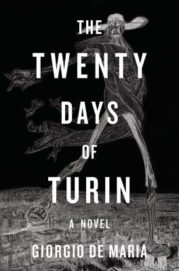 Giorgio De Maria
Giorgio De Maria
Translated by Ramon Glazov
Liveright ($24.95)
by Rick Henry
A good horror story requires monstrosity. Giorgio De Maria's The Twenty Days of Turin features the worst of the worst—the abyss, the unnamable, the unknowable, all of which is a monstrosity as malevolent as can be. In his expression of existential-social terror, De Maria joins writers such as Lovecraft and Poe in crafting a peculiarly literary kind of horror.
The place is Turin, Italy, where, in 1966, there was “a phenomenon of collective psychosis”: twenty days of mass insomnia, which had people wandering the city, zombie-like, at all hours. In the violence of that psychosis, a number of people died or were killed. Ten years later, the narrator of De Maria’s novel—a journalist—interviews one of the deceased's sister, a woman who “seemed to prefer one word above all the others: spirituality.” He meets with an “ear-witness” to the opening violence who heard several screams as the insomniacs traversed the city. He listens to recordings of creatures that has them evolving through several stages of sophistication with language. He discovers people who saw one of the “night-walkers” lurching along, “bit by bit, his movements seemed to get more agile.” That which is unknowable begins to take shape, as though the abyss is waging a war and needs to do so in terms that humans can understand.
As the journalist investigates, he has a number of direct engagements with the abyss, many of which are the standard business of horror stories: in a first contact, the phone rings, but no one responds to his “hello.” He notices a car following him. He receives a letter from a person he doesn't know and he enters into a strange correspondence. There are knockings on his door. A murder. A warning from a nun to stop looking into things he knows nothing about.
Against the abyss, De Maria offers spirituality, but not the spirituality of organized religion (indeed, the journalist is rebuffed by the Catholic church on several occasions). The journalist wanders the streets and encounters an oddly ritualized 'happening' complete with psychedelics, flowers, and chanting reminiscent of the 1960s. One of the participants is the deceased's sister. A young man hands the journalist a pamphlet that identifies sins—among them “an 'inattentiveness' toward 'that which seems invisible around us, but is no less worth of our concern.” The pamphlet continues:
Take heed! . . . Unless you repent, unless you pay attention not only to yourself but also to what you mightn't assume to be yourself, the wrath of God, which can express itself through all things, shall newly smite you down! The 'Twenty Days of Turin' were the final warning of the LORD!” (57-58)
The journalist does not take heed. He throws the pamphlet away and returns to his apartment and, perforce, his attention to art in its various manifestations. None of De Maria's examples, however, allow for an aesthetic steeped in unifying harmony, or intranscendence, either of which might suggest an escape, even as escape suggests a kind of inattention that would still be subject to the wrath of God. Instead, there is the possibility of achieving the spiritual through art, so long as the aesthetic delights in disharmony, in dischord. In short, an aesthetic that moves toward the abyss, toward the sublime.
Once in his apartment, the journalist comforts himself with Mozart's Flute Concerto No. 1 in G Major, a concerto rife with its own dissonances. He finds his lost copy of Robert Musil's Posthumous Papers of a Living Author and lands upon a passage that talks about that which is not noticed, a passage from a writer whose vision is, to put it mildly, expansive. The journalist encounters sculptures that offer their own disturbing violations of what it is to be a sculpture: they exchange positions in a public square and they fart. In what is the most important artistic encounter, the journalist discovers a strange library, a depository of people's personal writings, anxieties, desires, and outpourings that are manifestations of psychosis. Perhaps, if the journalist can engage the library as if it were part of himself rather than something to objectify, he might avoid the wrath of God?
In the end, De Maria’s novel is worth reading not only to discover the conclusion to the drama, but to revel in the artistic response to the social upheavals in Italy as outlined in an excellent introduction to the short novel by the translator. One has to hope that art is not merely a buffer or distraction, but the grand defense against the abyss.
